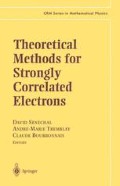Abstract
The conserving approximation scheme to many-body problems was developed by Kadanoff and Baym using the functional-derivative approach. Another approach for the Hubbard model also satisfies conservation laws, but in addition it satisfies the Pauli principle and a number of sum rules. A concise formal derivation of that approach, using functional derivatives, is given in this conference paper to highlight formal analogies and differences with conserving approximations.
Access this chapter
Tax calculation will be finalised at checkout
Purchases are for personal use only
Preview
Unable to display preview. Download preview PDF.
5 References
G. Baym, Phys. Rev. 127 (1962), 1391.
L.P. Kadanoff and G. Baym, Quantum Statistical Mechanics, Benjamin, Menlo Park, 1962.
N.E. Bickers and D.J. Scalapino, Ann. Physics 193 (1989), 206.
Y.M. Vilk and A.-M.S. Tremblay, J. Physique I France 7 (1997), 1309.
Y.M. Vilk and A.-M.S. Tremblay, Europhys. Lett. 33 (1996), 159; J. Phys. Chem. Solids 56 (1995), 1769.
P.C.E. Stamp, J. Phys. F: Met. Phys. 15 (1985), 1829.
S. Allen and A.-M.S. Tremblay, Phys. Rev. B 64 (2001), 075115/1–14.
B. Kyung, S. Allen, and A.-M.S. Tremblay, Phys. Rev. B 64 (2001),075116.
P.C. Martin and J. Schwinger, Phys. Rev. 115 (1959). This paper also contains numerous references to previous work.
For a review, see K.S. Singwi and M.P. Tosi, in eds. H. Ehrenreich, F. Seitz, and D. Turnbull, Solid State Physics, Vol. 36 (Academic, New York, 1981), p. 177; S. Ichimaru, Rev. Modern Phys. 54 (1982), 1017.
Y.M. Vilk, L. Chen, and A.-M.S. Tremblay, Phys. Rev. B Rapid Comm. 49 (1994), 13267.
B. Kyung, J.-S. Landry, D. Poulin, and A.-M.S. Tremblay, Phys. Rev. Lett. 90 (2003), 099702.
A.F. Veilleux, A.-M. Daré, L. Chen, Y.M. Vilk, and A.-M.S. Tremblay, Phys. Rev. B 52 (1995), 16255.
A.-M. Daré, Y.M. Vilk, and A.-M.S. Tremblay, Phys. Rev. B 53(1996), 14236.
N. Bulut, D.J. Scalapino, and S.R. White, Phys. Rev. B 47 (1993), 2742; N.F. Berk and J.R. Schrieffer, Phys. Rev. Lett. 17 (1966), 433.
S. Allen, H. Touchette, S. Moukouri, Y.M. Vilk, and A.-M.S. Tremblay, Phys. Rev. Lett. 83 (1999), 4128; Y.M. Vilk, S. Allen, H. Touchette, S. Moukouri, L. Chen, and A.-M.S. Tremblay, J. Phys. Chem. Solids 59 (1998), 1873.
S. Moukouri, S. Allen, F. Lemay, B. Kyung, D. Poulin, Y.M. Vilk, and A.-M. S. Tremblay, Phys. Rev. B 61 (2000), 7887.
S. Allen, Ph.D. Thesis, Université de Sherbrooke, 2000 (unpublished).
S. Roy, M.Sc. thesis, Université de Sherbrooke, 2002 (unpublished).
A.-M. Daré (unpublished).
S. Allen, B. Kyung, and A.-M.S. Tremblay (unpublished).
B. Kyung, J.-S. Landry, and A.-M.S. Tremblay, cond-mat/0205165.
B. Kyung, Phys. Rev. B 63 (2000), 014502; Phys. Rev. B 64 (2001), 104512.
S. Allen (unpublished).
Editor information
Editors and Affiliations
Rights and permissions
Copyright information
© 2004 Springer-Verlag New York, Inc.
About this chapter
Cite this chapter
Allen, S., Tremblay, A.M.S., Vilk, Y.M. (2004). Conserving Approximations vs. Two-Particle Self-Consistent Approach. In: Sénéchal, D., Tremblay, AM., Bourbonnais, C. (eds) Theoretical Methods for Strongly Correlated Electrons. CRM Series in Mathematical Physics. Springer, New York, NY. https://doi.org/10.1007/0-387-21717-7_8
Download citation
DOI: https://doi.org/10.1007/0-387-21717-7_8
Publisher Name: Springer, New York, NY
Print ISBN: 978-0-387-00895-0
Online ISBN: 978-0-387-21717-8
eBook Packages: Springer Book Archive

